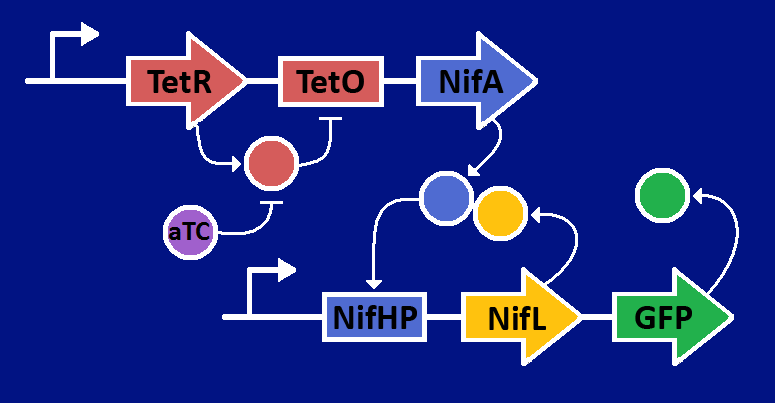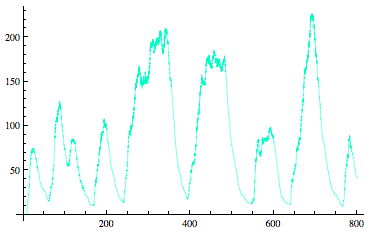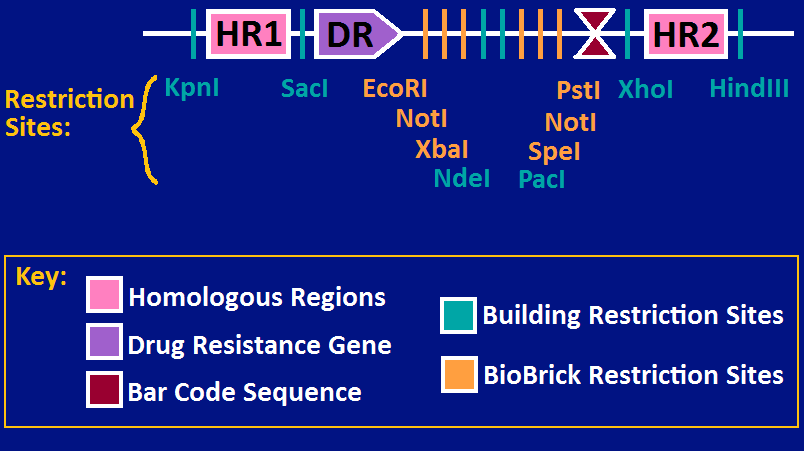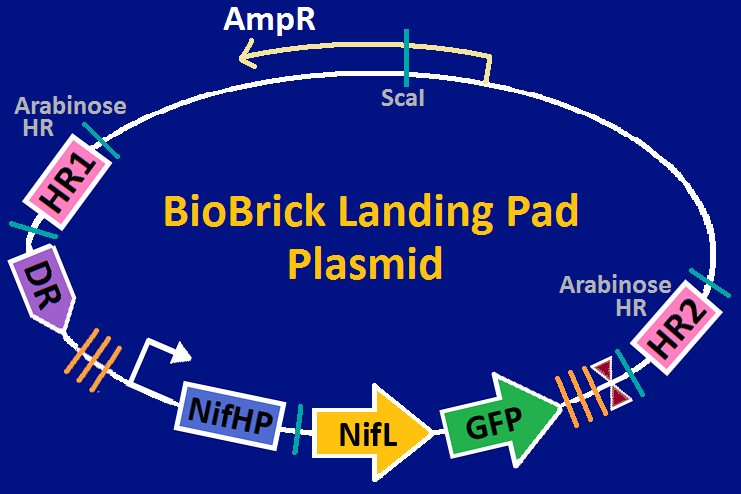Team:Michigan/Project
From 2008.igem.org
| Line 22: | Line 22: | ||
The tetR system regulates the levels of nifA. A constitutive promoter drives the TetR gene. At its resting state of our circuit, TetR completely represses the production of NifA. However, addition of anhydrotetracycline prevents the Tet protein from binding to tet promoter, allowing for a "constitutive" production of NifA as long as the levels of anhydrotetracycline are kept constant. This module allows us to tune the levels of NifA by adjusting the amount of anhydrotetracycline we add. | The tetR system regulates the levels of nifA. A constitutive promoter drives the TetR gene. At its resting state of our circuit, TetR completely represses the production of NifA. However, addition of anhydrotetracycline prevents the Tet protein from binding to tet promoter, allowing for a "constitutive" production of NifA as long as the levels of anhydrotetracycline are kept constant. This module allows us to tune the levels of NifA by adjusting the amount of anhydrotetracycline we add. | ||
| - | |||
| - | |||
| - | |||
| - | |||
| - | |||
| - | |||
| - | |||
| - | |||
| - | |||
| - | |||
|} | |} | ||
| Line 53: | Line 43: | ||
|} | |} | ||
| + | |||
| + | |||
| + | {|class="wikitable" border="0" cellpadding="10" cellspacing="1" style="padding: 1px; background-color:dodgerblue; border: 1px solid mediumblue; text-align:center" | ||
| + | !width="10%" align="left" valign="top" style="background:gold; color:black"| | ||
| + | <font color=navy> | ||
| + | = '''<font color=dodgerblue size=6>Landing Pads</font>''' = | ||
| + | |||
| + | A landing pad is tool used to place synthetic operons on a chromosome. We will be using two landing pads for our project: the arabinose landing pad and leucine landing pad. Both of these plasmids will replace the respective metabolic operons with our desired subcloned genetic elements. The leucine landing pad was constructed by a former member of the Ninfa lab, Dong Eun Chang. The arabinose landing pad was a part of our iGEM 2007 project, and was worked on by Alyssa Delke and Khalid Miri. Our reason for using these pieces is to limit the noise in our system so that hopefully we can see more sustained oscillations than previous synthetic clocks have given. | ||
| + | |||
| + | <br><div align=center> [[Image:Landing Pad Polylinker.png]]<br>BioBrick Landing Pad Polylinker<br><br> | ||
| + | |||
| + | [[Image:Landing pad plasmid.png]]<br>Arabinose Landing Pad with our second operon inserted<br><br> | ||
| + | |||
| + | [http://synthbio.engin.umich.edu/wiki/index.php/BioBrick_Landing_Pad <font color=navy size=3> Learn more about Landing Pads Here!</font>] | ||
| + | </div><br> | ||
| + | |} | ||
| + | <br><br><br> | ||
Revision as of 04:58, 28 October 2008
|
|---|
|
Project DescriptionCircadian ClocksShort background on circadian clocks... why they're important, why they're studied, maybe who studies them... Our Project: The SequestillatorWe can subdivide our clock into three parts: the tetR system, the activator module, and the repressor module. The activator module consists of the tet promoter driving the NifA gene. The NifA protein binds to the nifHp promoter of the repressor module, activating transcription of the NifL gene. Once NifL dimerizes, it can bind to the NifA hexamer, hence preventing NifA from binding to NifHp. This sequestration effect provides the clock's negative feedback loop that is essential for oscillations. The tetR system regulates the levels of nifA. A constitutive promoter drives the TetR gene. At its resting state of our circuit, TetR completely represses the production of NifA. However, addition of anhydrotetracycline prevents the Tet protein from binding to tet promoter, allowing for a "constitutive" production of NifA as long as the levels of anhydrotetracycline are kept constant. This module allows us to tune the levels of NifA by adjusting the amount of anhydrotetracycline we add. |
|---|
Sequestilator Modeling |
Sequestilator FabricationIf you like the way this looks, you could put a summary of what you built here and then we can have a separate page for fabrication, which might be a good idea. |
|---|
 "
"




